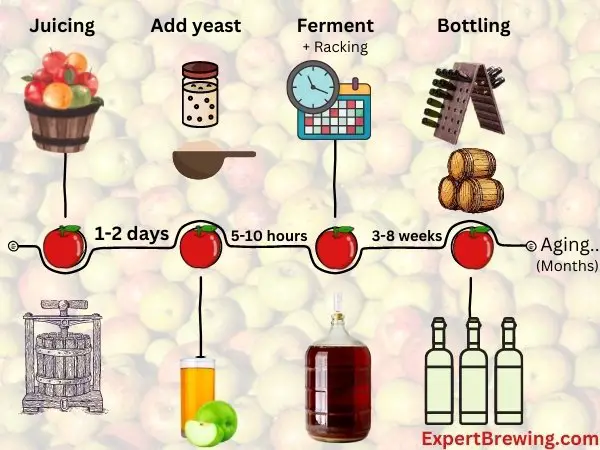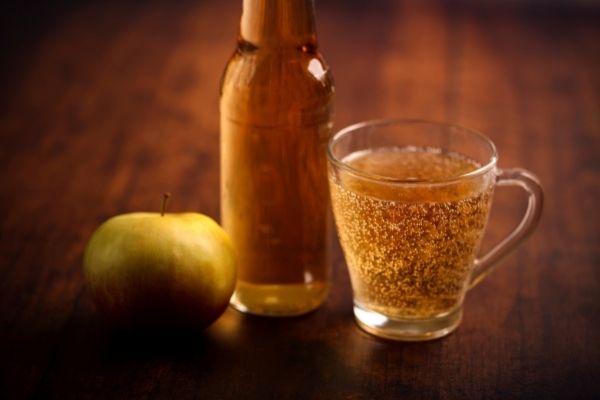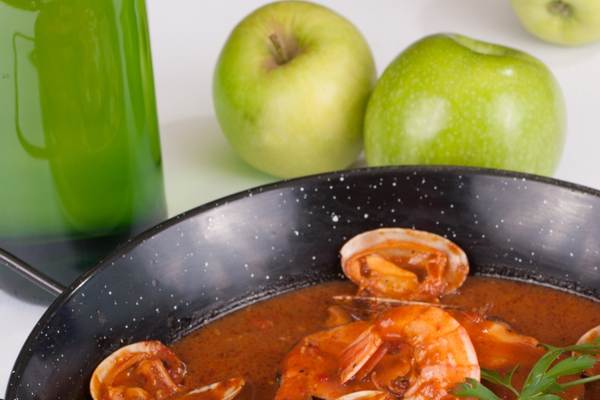Welcome to the world of oaked hard cider, a delightfully complex and flavorful beverage with deep historical roots. Throughout this guide, we will explore its intriguing history from ancient European traditions to its modern resurgence in craft culture.
Beyond that, we’ll dive into the art and science behind the brewing process itself – selecting choice apples, mastering oak aging techniques, perfecting fermentation practices, and discovering how this flavorful libation has grown to be more than just your average apple cider.
Key Takeaways
- Oaked hard cider has a rich history dating back to ancient European civilizations and is currently experiencing a resurgence in modern craft culture.
- High-quality apples, proper fermentation techniques, and oak aging are essential for creating delicious oaked hard cider.
- Selecting the right type of oak barrel or imparting oak flavor through other techniques can greatly impact the final taste profile of your oaked hard cider.
- Proper bottling and storage are important to maintain the quality and freshness of your oaked hard cider over time.
History Of Oaked Hard Cider
Oaked hard cider has a rich history that dates back to the European heritage traditions of cider making, where barrels were used to store and transport the fermented apple juice.
The Origins Of Hard Cider And Oak Aging
The origins of hard cider and oak aging can be traced back to ancient European civilizations where cider production was a popular practice amongst Romans and Celts. In these early days, apples were naturally crushed underfoot and then left to ferment in wooden containers made from oak or other locally sourced wood, thus resulting in an accidentally oaked hard cider.

As time went on, oak barrels became integral components for fermentation and aging processes across various beverages such as wine, beer, and spirits. By utilizing techniques perfected by expert coopers, barrel makers would specifically design their products with precise amounts of charred surfaces on the inside to enhance both flavor profiles and shelf lives for alcoholic drinks like whiskey.
As traditional methods merged with creative innovation during centuries past, those involved in hard cider making also embraced this process – incorporating it into their own brewing practices as they sought more refined tastes from their ciders that blended together woody notes with fruit-forward essences reminiscent of apples picked straight off tree branches.
The Rise And Fall Of Cider In The US
In the 18th century, cider was a ubiquitous drink in America. People grew their apples and fermented them for personal consumption or commercial sale. It was even an acceptable form of payment for workers on farms! However, with the rise of lager beer and the industrialization of food processing, cider lost popularity in the early 20th century.
The temperance movement and prohibition also dealt heavy blows to the industry.
The Emergence Of Oaked Hard Cider In Modern Craft Cider Culture
Oaked hard cider has emerged as a popular addition to modern craft cider culture in recent years. This drink is made by aging hard cider in oak barrels, which impart earthy and funky flavors to the drink.
Craft cider makers use different types of oak barrels to achieve unique flavor profiles. Some may use new oak or charred oak, while others may opt for previously used bourbon or whiskey barrels for added complexity.
Oaked hard ciders have become popular among those who appreciate artisanal drinks with complex flavor profiles that complement food well. These ciders are often served alongside hearty meals like roasted pork or grilled steak due to their rich flavors and tannic structure.
The Brewing Process Of Oaked Hard Cider
To create oaked hard cider, high-quality apples are selected and juiced before undergoing fermentation with yeast; during this process, oak flavor can be imparted to the cider through a variety of techniques such as barrel-aging or adding oak chips.
Selecting High-Quality Apples For Oaked Hard Cider
When selecting apples for oaked hard cider, it’s essential to choose high-quality fruit that will impart a balance of sweetness and acidity in the final product. While any apple can be used for making cider, traditional varieties such as Culinary or Crab apples are preferred due to their tannins content.
Different apple varieties have varying levels of sugar content, acidity, and tannins. For instance, the bittersweet apple (high tannin and low acid) is ideal for adding body and character to a dry cider while balancing out its tartness.
On the other hand, sweet apples (high sugar) like Honeycrisp can provide natural sweetness without being overpowering.
It’s crucial to ensure that you source your apples from local growers during peak season when they’re freshest if possible. This practice helps guarantee robust flavors and aromas while supporting small businesses within your community in return.
Extracting Juice And Preparing For Fermentation
To make oaked hard cider, the first step is to extract juice from high-quality apples and prepare it for fermentation. Here are the steps to follow:
1. Choose your apples: Select culinary or crab apples that are ripe and free of blemishes or bruising.
2. Wash and sanitize: Rinse the apples with water and let them dry naturally before sanitizing every cutting board, knife, juicer, and fermenting equipment you will use.
3. Cut the apples: Cut the apples into small pieces using a sharp knife, making sure to remove any seeds or stems.
4. Press the juice: Once cut into small pieces, press them using a cider press or a juicer until you get all of the juice out of the apples.
5. Add enzymes (optional): To ensure that all of the sugar in your apple juice is fermented, add enzyme supplements to break down complex sugars into simpler ones.
6. Measure gravity: Use a hydrometer to measure gravity levels of your apple juice at this point. Cider-makers aim for around 1.050-1.070 specific gravity when starting cider making.
7. Adjust acidity/sugar levels (optional): If necessary, adjust acidity or sugar levels in your apple juice by adding citric acid or dextrose, respectively.
8. Pitch yeast : Add wine or champagne yeast on top of your newly-pressed apple juice before stirring it well.
9. Ferment: Cover your container (bucket/carboy) to keep insects out; then transfer container(s) containing freshly pressed apple juice with added yeast bait inside to a room temperature range between 60°F – 70°F degrees Fahrenheit; this is an optimal temperature range for most yeasts.
10.Once Primary fermentation is finished which takes about 2 weeks time period for most ciders; impurities will have sunk to bottom leaving fresh cider above — transfer the liquid from primary vessel to secondary vessel using siphon tubing, making sure to leave any sediment or solids behind. This step is to remove any impurities left over before aging starts.
Now that you have extracted the juice and prepared it for fermentation, you can add it to an oak barrel to impart a unique woody flavor before aging and bottling.
Techniques For Imparting Oak Flavor
One of the main reasons why oaked hard cider is so popular among craft cider enthusiasts is because the oak barrels used during fermentation can impart a variety of unique flavors to the final product.
There are several techniques for incorporating oak flavor into hard cider, including using staves or cubes made from American, French, or Hungarian oak.
Another technique involves using different types of oak barrels for different stages of the brewing process. For example, some brewers will use new oak barrels during primary fermentation and then move their ciders to older barrels once secondary fermentation has begun.
As with all aspects of cider making, experimenting with different techniques and ingredients is key when trying to achieve that perfect balance of apple sweetness and earthy woodiness in your oaked hard cider.
Fermentation, Aging, And Bottling
During the fermentation process, yeast consumes sugar and produces alcohol and carbon dioxide; once complete, the cider is aged in oak barrels to impart a rich flavor and mouthfeel before being bottled and stored properly.
The Timeline For Oaked Cider Fermentation
The timeline for cider fermentation may vary depending on the method used, type of yeast, and desired outcome. Here’s a general breakdown of the process:

1. Primary Fermentation (3-8 weeks): After extracting juice from high-quality apples, it’s time to ferment with yeast. This stage usually takes two to four weeks, during which time the yeast converts natural sugars in the juice into alcohol.
2. Secondary Fermentation (2-8 weeks): This is when the cider is moved to a secondary vessel where it can settle and mature without exposure to oxygen. The amount of time spent in this stage can range from 2 to 8 weeks.
3. Aging in Oak Barrels (months): Once fermentation is complete, some cider makers prefer to age their product in oak barrels for additional flavor and aroma development. This step can take anywhere from several weeks up to several months depending on desired results.
4. Carbonation and Bottling: The final step involves carbonating the cider before bottling or kegging it for consumption. Carbonation can be achieved through natural carbonation methods or by adding CO2 under pressure.
By following these steps, you can create a delicious oaked hard cider that’s perfect for any occasion.
Monitoring And Controlling The Process
Monitoring and controlling the cider fermentation process is a crucial step in ensuring that the oaked hard cider turns out just right. During this phase, the sugar in the apple juice is converted into alcohol by yeast, which releases carbon dioxide as a byproduct.
The temperature and pH levels must be carefully monitored to ensure that fermentation occurs smoothly without any unwanted side effects like off-flavors or unpleasant aromas.
One way to monitor fermentation is through specific gravity readings taken with a hydrometer. This tool measures how dense the liquid is compared with pure water, giving you an idea of how much sugar has been converted into alcohol.
Additionally, monitoring pH levels will help determine when primary fermentation has finished and when it’s time for aging in oak barrels.
The Benefits Of Aging In Oak Barrels
Aging oaked hard cider in oak barrels provides many benefits to the final product. The oak imparts a subtle, woody flavor and aroma, adding complexity to the cider’s taste profile.

Oak barrels can also increase tannin extraction from the wood, giving a pleasant mouthfeel and enhancing the overall drinking experience. Aging in oak barrels can improve alcohol integration as well, allowing for a smoother finish.
Furthermore, barrel aging allows for natural oxidation during fermentation that reduces harshness by removing unwanted aromas or sulfur compounds. Lastly, oak-barrel-aged ciders tend to have increased longevity compared to unaged ciders since they are less likely to spoil quickly once bottled properly.
Bottling And Storing Properly
Proper bottling and storage of oaked hard cider can help preserve its flavor and aroma. Here are some tips to follow:
– Choose high-quality bottles that are specifically designed for carbonated beverages. Be sure they have strong, airtight caps or cork closures.
– Clean and sanitize your bottles thoroughly before filling them with cider. Any leftover bacteria or contaminants could spoil the flavor and cause off-tastes.
– Fill the bottles leaving a small amount of headspace to allow for carbonation. Make sure there aren’t any air pockets or bubbles in the liquid.
– Store your bottles in a cool, dark place with a consistent temperature range of 45-50 degrees Fahrenheit to encourage carbonation without risking over-carbonation or spoiled flavors.
– Allow the cider to carbonate naturally through bottle conditioning for at least two weeks or more before opening and enjoying.

Following these steps will ensure that your oaked hard cider remains fresh, flavorful, and perfectly carbonated until you’re ready to savor it.
Tasting Notes, Varieties, And Pairings
Discover the unique taste and aroma of oaked hard cider, with traditional, flavored, and barrel-aged varieties to try.
Characteristics Of Oaked Hard Cider
Oaked hard cider has a unique flavor profile that sets it apart from other ciders. It often has earthy, woody, and funky notes due to the oak barrels used during fermentation and aging.
Additionally, oaked hard cider can have subtle hints of vanilla or caramel as well.
Several varieties of oaked hard cider exist, ranging from traditional to barrel-aged and flavored types. For example, Pennsylvania hard cider is aged in oak barrels for several months producing vanilla-scented flavors with subtle caramel notes.
Traditional, Flavored, And Barrel-Aged Cider Varieties
Oaked hard cider is just one example of the different varieties available to cider enthusiasts. Traditional ciders tend to be dry and crisp, made from a blend of apple varieties that create a balance between sweetness, acidity, and tannins.

Flavored ciders, on the other hand, can range from sweet and fruity to spicy and savory.
Barrel-aged ciders have become increasingly popular in recent years as craft cider makers experiment with different types of wood barrels to impart unique flavors into their brews.
Oak barrels are commonly used due to their rich earthy quality which can lend vanilla-scented notes along with hints of smoke or leather depending on how long they’ve been aged in the barrel.
Pennsylvania Hard Cider is known for its traditional oak aging process that gives it a distinct woody taste while maintaining its crisp apple character.
Food Pairing Recommendations
Oaked hard cider is a versatile drink that can be paired with a variety of foods to create a harmonious flavor profile. Here are some food pairing recommendations to try:
1. Charcuterie and Cheese – Oaked hard cider pairs well with cured meats, such as prosciutto or salami, and aged cheese, such as cheddar or gouda.
2. Pork Dishes – The earthy and smoky flavors of oaked hard cider complement pork dishes, such as roasted pork loin or bacon-wrapped scallops.
3. Seafood – The crisp acidity of oaked hard cider balances the flavors of seafood, such as raw oysters or grilled shrimp.

4. Spicy Foods – The sweetness in oaked hard cider cuts through the heat of spicy foods, making it a great pairing for dishes like spicy stir fry or buffalo wings.
5. Root Vegetables – Oaked hard cider has an earthy quality that pairs well with root vegetables, such as roasted sweet potatoes or parsnips.
Pairing food with oaked hard cider is all about finding complementary flavors that enhance each other’s taste profiles. Experimenting with different pairings can lead to fantastic culinary experiences that can be enjoyed by everyone!
Serving Temperatures And Glassware Suggestions
When it comes to enjoying oaked hard cider, serving temperature and glassware are two essential aspects that can make or break the drinking experience. The ideal serving temperature for Oaked Hard Cider depends on personal preference but generally ranges from 45°F to 55°F.
When it comes to pairing with food, a tulip-shaped glass is an excellent choice for savoring every aspect of the aroma and taste without losing carbonation. A wine glass or snifter works well because they capture the nuances of a decent oaked hard cider’s aroma as you swirl before tasting.
In conclusion, enjoying oaked hard cider requires careful attention to details such as ideal serving temperatures and selecting the appropriate glassware that allows drinkers to get maximum enjoyment out of their beverage.
Conclusion
In conclusion, oaked hard cider is a unique and flavorful variation of the classic beverage. Its history dates back centuries and has played an important role in American culture.
If you’re interested in brewing your own batch of oaked hard cider, it’s important to select high-quality apples and utilize proper fermentation techniques.
When enjoying oaked hard cider, experiment with different varieties and food pairings to find what works best for you.
Still have questions about this tantalizing drink? Check out our frequently asked questions section for more information on all things oaked hard cider.




